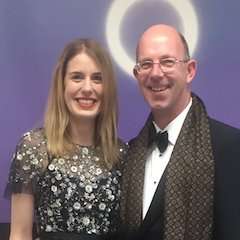As a writer, Ernst Theodor Amadeus Hoffmann’s fantastical stories helped shape Romanticism and inspired some wonderful music, even if it was occasionally sweetened into something more sugary, like Tchaikovsky’s Nutcracker. But Hoffmann had many strings to his bow. He considered music the highest form of art and his review of Beethoven’s Fifth Symphony helped define music criticism. Hoffmann was also a composer in his own right, although his works are seldom performed today. Our playlist therefore splits into works inspired by ETA and works composed by him, offering plenty of music to discover.
Inspired by ETA Hoffmann:
1Jaques Offenbach: Les Contes d'Hoffmann
Based on Jules Barbier’s eponymous play, Jacques Offenbach’s opéra fantastique tells the story of a man facing up to the eternal choice between love and art. Hoffmann himself regales his drinking buddies with tales of his past inspiring and disastrous loves. But there is more to the opera than nights of love, the Barcarolle or Olympia’s silly Doll Aria. It is also inescapably dark with some of Hoffmann’s best villains from Der Sandmann, Rat Krespel and Die Abenteuer der Sylvester-Nacht. [Elisabeth]
Click here to read more about Les Contes d’Hoffmann.
2Pyotr Ilyich Tchaikovsky: The Nutcracker
With all the glitter, candy and Sugar Plum Fairies, it’s hard to believe that Tchaikovsky’s fluffy Christmas ballet is based on one of ETA Hoffmann’s dark and sinister tales. The 1816 story, The Nutcracker and the Mouse King, tells how Drosselmeyer’s nephew falls victim to a curse and is turned into a nutcracker, defeats the evil, seven-headed mouse king on Christmas Eve and takes Marie Stahlbaum (Clara, in the ballet) to the magical doll kingdom where they are crowned king and queen. [Elisabeth]
Click here to read more about The Nutcracker.
3Robert Schumann: Kreisleriana
Robert Schumman identified strongly with ETA Hoffmann and with his fictional character, Johannes Kreisler – an eccentric Kapellmeister prone to extreme changes of mood, not unlike Schumann’s own alter egos, the fiery Florestan and the dreamy Eusebius. In this piece, the two facets constantly alternate with each other, leading to passionate outbursts and intimate melodies, almost like a love letter to Schumann’s beloved Clara: “Play my Kreisleriana sometimes! There's a very wild love in a few movements, and your life and mine and many of your looks.” [Elisabeth]
Click here to read more about Kreisleriana.
4Léo Delibes: Coppélia
Léo Delibes composed the music for this comic ballet, which is inspired by Hoffmann’s creepy story, Der Sandman, which later featured in The Tales of Hoffmann. In the ballet, the inventor Dr Coppélius has made a life-sized mechanical doll which is so life-like that young villager Frantz becomes besotted with it… much to the irritation of his girlfriend, Swanilda, who decides to break into the workshop. [Mark]
5Adolphe Adam: La Poupée de Nuremberg
Another work inspired by Der Sandman – and predating them by some margin – was Adolphe Adam’s opéra-comique, La Poupée de Nuremberg. In it, toy shop owner Cornelius is duped into believing the doll he has created has come to life. The overture reveals graceful, dancelike tunes – just what one would expect from the composer of the first great classical ballet, Giselle. [Mark]
Composed by ETA Hoffmann:
1Undine
ETA Hoffmann’s magical opera Undine is considered one of the first German Romantic operas. However, this is mainly due to the operatic material rather than the music, which is still strongly influenced by the Classical period. It might not be as melodious as Albert Lortzing’s opera of the same name, but it delves more deeply into the characters’ souls. Even Carl Maria von Weber wrote an enthusiastic review: “an art work complete in itself, in which partial contributions of the related and collaborating arts blend together, disappear, and, in disappearing, somehow form a new world” [Elisabeth]
2Symphony in E flat major
ETA Hoffmann’s Symphony in E flat major was composed during 1806 and premiered in Warsaw. It takes Haydn’s series of London Symphonies as its inspiration – in 1803, Hoffmann noted in his diary that “Haydn shall be my master”. The first movement has a slow introduction but soon breaks into a ferocious Allegro full of Sturm and Drang drama. The Andante con moto second movement has a pastoral feel, while the Minuet and Trio take the form of a canon. In a neat twist, Hoffmann draws the secondary theme of the lively finale from the symphony’s slow introduction. [Mark]
3Arlequin
Hoffmann composed music for the ballet Arlequin in 1808, just a few years after Beethoven’s The Creatures of Prometheus. It contains around half an hour of music, a sequence of short dances and clownish character pieces involving Harlequin, Pierrot and Scaramouche that are Beethovenian in flavour. [Mark]
4Miserere
Written in 1809, the Miserere builds a bridge between the musical language of Hoffmann’s time and the composer’s admired style of Palestrina. There are some short a cappella passages for five voices, but the most striking thing about the work is its smallness: none of the twelve individual movements lasts longer than five minutes. Diary entries attest to the composer’s inner tension: “Somewhat morbid state or rather mood towards the romantically religious.” [Elisabeth]
5Piano Sonata in A major
Hoffmann composed five piano sonatas between 1805 and 1808. He himself described these sonatas as works which are “set in the older style, combined with the more cheerful melodic drive of the new”. If Haydn was the model for Hoffmann’s Symphony, Mozart seems to have been his inspiration here. [Mark]




